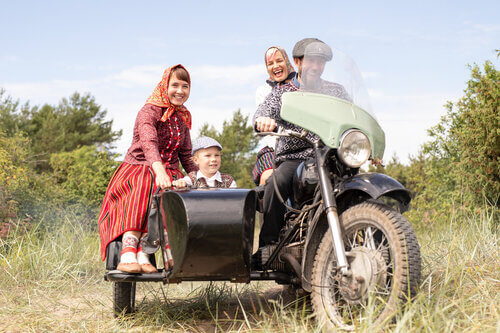10 fascinating facts about the estonian language
What makes Estonia so special? Find out in our new series on Estonia - learn some fun and lesser-known facts about the culture and history of the digital nation!

What comes to mind when I ask you what you know about Estonia?
You’ll probably start with the country’s digital prowess, or the success of unicorns like Skype or Bolt, or maybe even e-Residency. Indeed, despite its compact geography and population, the country has made significant strides in history through technology, earning the reputation of being a digital nation. But I can almost guarantee you that if I asked a native Estonian the same question, they would probably mention something about the country’s rich history, unique language, or the delicacies of its food.
We Estonians take great pride in our culture and language.
To celebrate 10 years of e-Residency, the team thought it would be a great idea to present a series of posts with insights on Estonian history, culture, language, and food to our readers.
In this article, I’ll cover the Estonian language, whose intricacies and innovations play a crucial role in Estonian identity. Discover 10 fascinating facts about the Estonian language, its unique grammar, ancient terminology, and Estonia's innovative approach to digital language inclusivity.
10 Fun facts about the Estonian Language
10 fun facts about the Estonian language
1. One of the smallest national languages
Estonian is one of the smallest languages in the world that fulfils all the functions required for a national language.

Estonian is the official language of Estonia and is spoken by approximately 1.1 million people. Estonian belongs to the Finno-Ugric language branch and is closely related to Finnish and distantly to Hungarian.
Did you know that many Estonians are bilingual?
Due to historical ties, many Estonians are proficient in both Estonian and Russian, which can be advantageous for business dealings in the region. Since Estonia regained independence in 1991 and looked towards the West for economic and international dealings, more and more people in Estonia were taught English in school. Nowadays, about half the population speak English as a second language.
2. One of the most challenging languages to learn
Estonian stands out as one of the most challenging languages in the world.
With 14 grammatical cases, no grammatical gender, and a pronunciation rich in vowels, Estonian poses considerable difficulty for learners.
Furthermore, Estonian shows the process of word changes depending on their grammatical context. For example, the process shifts "tuba" (room) to "toa" (of the room), showing the language's complex grammatical structure.
3. One without gender
You might have heard the joke saying "Estonians have no sex and no future" referring to the fact that our language does not have genders or a future tense.
Jokes aside, in the Estonian language, there is no differentiation between "he" and "she"; both are referred to as "tema", exemplifying their linguistic equality.
4. One without future

As we Estonians put all our energy into future innovations, we forgot to add the future tense into our language. We use the present case with a time-related adverb to indicate the future tense.
For instance, an English speaker would say ‘’We will go to a sauna party tomorrow’’, using the simple future tense. Estonians treat tomorrow as if it were today: ‘’We go to the sauna party tomorrow’’.
5. One with long compound words
Compared to many other languages, written Estonian can be challenging to learn due to the multitude of rules that determine whether words should be written as one or separate words. In English, most words are written independently, but in Estonian (similarly to German), you will come across long compound words.
A funny example is KUULILENNUTEETUNNELILUUK which means the hatch a bullet flies out of when exiting a tunnel. This tongue twister of a word is also a palindrome - meaning that it reads the same in reverse.
6. One with ancient origins
The Estonian language is rich in ancient terminology, some of which could have evolved thousands of years ago.

Estonians use phrases like "tuule käes, vihma käes, " which translates to "in the hand of wind or rain."
It is also interesting how an Estonian would say that they got scratched by a cat. They say: "ta sai kassi käest küünistada," which means "he/she was scratched by the hand of a cat".
People in ancient times believed that the natural world, particularly animals and plants, had power over humans. Usually, these powers were symbolically represented by a hand.
7. One with unusual letters
The Estonian alphabet includes unusual special letters.
Estonia is known for its unique alphabet, which includes letters like õ, ä, ö, and ü. Surprisingly, locals of Saaremaa Island in Estonia often have trouble with accurately pronouncing the letter 'õ', typically replacing it with 'ö'.
A few examples:
- JÄÄÄÄR - edge of the ice, "jää" means ice and "äär" means edge.
- KUUUURIJA - moon researcher, "Kuu" for the moon and "uurija" for the researcher.
- ÖÖTÖÖ - night shift, "öö" meaning night and "töö" meaning work.
- JÕULULAULULAULJA means a Christmas caroller.
8. One designed for tongue twisters
Another interesting tongue twister is KUMMIKUTES KUMMITUS KUMMITAS KUMMUTIS, which translates to "a ghost with rain boots haunted the chest of drawers".
Such phrases reflect Estonian's linguistic difficulty, engaging both native speakers and those unfamiliar with the language.
9. One with digital inclusivity in mind
E-Estonia is making significant strides in language inclusivity.

Estonia has developed multilingual digital services to provide accessibility on the local and international levels. In addition to almost universal accessibility for English speakers, Estonia aims to increase its global reach as a digital society by providing equal accessibility for different nations.
The Estonian e-Residency programme offers non-Estonians access to Estonian services in English through transparent and innovative solutions. Through language and technology, Estonia is more visible to international entrepreneurs and leaves a mark on the global business landscape.
By investing in contemporary digital resources such as machine translation tools, and various language technology initiatives, the Estonian language is more accessible and easily usable in the digital landscape.
Here are a few must-known words and phrases to use as a digital individual:
- ‘Digitark’ means digitally smart
- ’asjaajaja’ (clerk, secretary), but it also reflects the person who gets things done!
- ‘Tööloom’ refers to a work animal
- ‘Raha ei kasva puu otsas’ (Money doesn't grow on trees), also reflects there's hard work behind every success.
10. One to Learn!
Estonia places a strong emphasis on language education in its schools. Estonia endorses language education in which schools provide students with the option of learning either German, Russian, or Finnish next to the compulsory English. Also, many schools offer languages like French, Spanish or Chinese language programmes to help students boost their language proficiency.
Did you know that to obtain long-term residency in Estonia you have to pass a B1 Estonian language test?
Due to the small size of the language group, people who migrate to Estonia must try to learn the language. One of the key requirements for Estonian citizenship is to pass the Estonian B1-level language test. There are a wide range of online and in-person language learning courses to support making the Estonian language accessible to everyone.
Our colleagues at Work in Estonia through their International House offer free Estonian language courses at different levels for new migrants to the country.
Until next time!
Keep an eye out for more in our series of posts celebrating e-Residency's 10th anniversary—you definitely don't want to miss the next article about food! For a little taster (mind the pun), you can watch this video of our e-Residency Envoys and Community Leaders enjoying some Estonian delicacies:
I hope you enjoyed reading this list of fun facts!
Whenever Estonia comes up in a quiz, remember that our country is not only renowned for its innovative ideas and unicorn startups but also for our unique, beautiful (and sometimes bizarre) national language.
PRO TIP: An easy way to win us over is to learn a few Estonian words, which will warm the hearts of even the most reserved Estonians.

Grete Rahnel is a creative professional from Estonia with extensive experience working as a creative and technical writer for multiple international companies. With a Bachelor’s degree in English Language and Literature, Grete brings a strong foundation in language and a passion for storytelling to her work, blending creativity with technical precision.
More from e-Residency
- Sign up for our newsletter
- Watch fresh video content - subscribe to our Youtube channel
- Meet our team and e-residents - register for our next Live Q&A